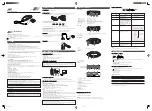
3
MZ-N520/N520CK
On power sources
•
Use house current, nickel metal hydride
rechargeable battery, LR6 (size AA) battery,
or car battery.
•
For use in your house: Do not use any other
AC power adaptor since it may cause the
recorder to malfunction
.
•
Connect the AC power adaptor to an easily
accessible AC outlet. Should you notice an
abnormality in the AC power adaptor,
disconnect it from the AC outlet immediately.
•
The recorder is not disconnected from the AC
power source (mains) as long as it is
connected to the wall outlet, even if the
recorder itself has been turned off.
•
If you are not going to use this recorder for a
long time, be sure to disconnect the power
supply (AC power adaptor, dry battery,
rechargeable battery, or car battery cord). To
remove the AC power adaptor from the wall
outlet, grasp the adaptor plug itself; never pull
the cord.
Polarity of the
plug
TABLE OF CONTENTS
1.
SERVICING NOTES
...............................................
4
2.
GENERAL
...................................................................
5
3.
DISASSEMBLY
3-1. Case (Lower) ...........................................................
7
3-2. Upper Panel Section ................................................
7
3-3. LCD Module, Button (Control) ...............................
8
3-4. MAIN Board ............................................................
8
3-5. Mechanism Deck (MT-MZN710-177) ....................
9
3-6. Set Chassis Assy ......................................................
9
3-7. OP Service Assy (LCX-5R) .................................... 10
3-8. Holder Assy ............................................................. 11
3-9. DC Motor (Sled) (M602) ........................................ 11
3-10. DC Motor (Over Write Head Up/Down) (M603),
DC SSM18B Motor (Spindle) (M601) ................. 12
4.
TEST MODE
.............................................................. 13
5.
ELECTRICAL ADJUSTMENTS
......................... 19
6.
DIAGRAMS
6-1. Block Diagram ......................................................... 40
6-2. Printed Wiring Board – MAIN Board (Side A) – ... 41
6-3. Printed Wiring Board – MAIN Board (Side B) – ... 42
6-4. Schematic Diagram – MAIN Board (1/4) – ........... 43
6-5. Schematic Diagram – MAIN Board (2/4) – ........... 44
6-6. Schematic Diagram – MAIN Board (3/4) – ........... 45
6-7. Schematic Diagram – MAIN Board (4/4) – ........... 46
6-8. IC Pin Function Description .................................... 51
7.
EXPLODED VIEWS
7-1. Case Section ............................................................ 57
7-2. Chassis Section ........................................................ 58
7-3. MAIN Board Section ............................................... 59
7-4. Mechanism Deck Section-1 (MT-MZN710-177) ... 60
7-5. Mechanism Deck Section-2 (MT-MZN710-177) ... 61
8.
ELECTRICAL PARTS LIST
............................... 62
CAUTION
Use of controls or adjustments or performance of procedures
other than those specified herein may result in hazardous ra-
diation exposure.
Notes on chip component replacement
• Never reuse a disconnected chip component.
• Notice that the minus side of a tantalum capacitor may be dam-
aged by heat.
Flexible Circuit Board Repairing
• Keep the temperature of the soldering iron around 270 ˚C dur-
ing repairing.
• Do not touch the soldering iron on the same conductor of the
circuit board (within 3 times).
• Be careful not to apply force on the conductor when soldering
or unsoldering.
UNLEADED SOLDER
Boards requiring use of unleaded solder are printed with the lead-
free mark (LF) indicating the solder contains no lead.
(Caution: Some printed circuit boards may not come printed with
the lead free mark due to their particular size)
: LEAD FREE MARK
Unleaded solder has the following characteristics.
• Unleaded solder melts at a temperature about 40 ˚C higher than
ordinary solder.
Ordinary soldering irons can be used but the iron tip has to be
applied to the solder joint for a slightly longer time.
Soldering irons using a temperature regulator should be set to
about 350 ˚C .
Caution: The printed pattern (copper foil) may peel away if the
heated tip is applied for too long, so be careful!
• Strong viscosity
Unleaded solder is more viscous (sticky, less prone to flow) than
ordinary solder so use caution not to let solder bridges occur
such as on IC pins, etc.
• Usable with ordinary solder
It is best to use only unleaded solder but unleaded solder may
also be added to ordinary solder.
Summary of Contents for MZ-N520CK
Page 67: ...67 MZ N520 N520CK MEMO ...




































